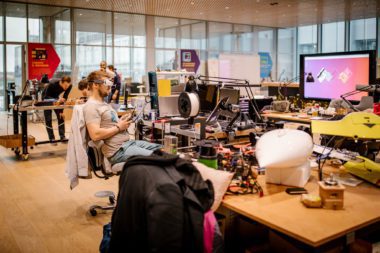In this blog post, we would like to show you our Knowledge Creation Cube: a tool that enables us to present and plan innovation and knowledge processes in an agile and dynamic way. The Cube is a handy yet essential instrument for wielding the complex challenges of “New Work”. It can evaluate processes subject to constant change and it helps us to comprehend these changes without losing the bigger picture. Finally, it can also inspire the design of office spaces. So to begin with, let us start by outlining the challenges that inspired us to develop the Knowledge Creation Cube.
Innovation and knowledge processes are among the most confusing and complex tasks of a company. They are diverse, heterogeneous, and seem to lack common ground. Even so, every organization that strives for innovation must do two things. First, it has to keep track of a multitude of knowledge and innovation processes. That is to say, it has to stay on top of things. Second, it has to understand the history of innovation processes. Only then can it use them in a meaningful or target-oriented way. Granted, it is true that confusion, chaos, and chance often contribute to great innovations. Yet, innovation work should not happen at random. Rather, it is necessary to establish certain framework conditions for innovation work. Setting the framework is crucial for innovation to be successful altogether.
But first of all: why can we combine knowledge and innovation processes? It makes sense to think about them in a unified way, since, after all, knowledge processes (among other things) constitute innovation. In other words, innovation emerges from knowledge processes.
For example, scientists and engineers first learned how animals and objects can fly. The innovation of the plane emerged from this (theoretical and practical) technological knowledge.
It’s a simple rationale. To understand and design innovation processes, one must understand the underlying knowledge processes.
Innovation as a dynamic and holistic knowledge process
It is a difficult task for any organization or company to characterize its knowledge and innovation processes – and such is the task to plan them. But how can they make these processes comprehensible at all? And to be precise; how can they be (re-)presented in a holistic manner, in a “synoptic view”, so to speak?
You may wonder if it is necessary to understand these processes in such a way in the first place. Why is it so important to reach for the bigger picture? There are two reasons for this:
The dynamic nature of innovation
First, innovation and knowledge work is not only confusing. It is also prone to change. This means not only that innovation projects can differ from one another. It simply means that a particular project can change significantly within its lifetime.
For example, at the beginning of a project, only a small group of “innovation workers” gets things started. Yet, later the entire organization plays a role and all employees can get involved. Moreover, innovations do not remain new. They age and grow up to be established commodities. Once they are, we treat them accordingly and not as products and services that have to assert themselves yet.
All these changes demand a dynamic representation of innovation and knowledge processes. Only then can we keep an overview of how innovation and knowledge processes unfold over time.
Moreover, different stages of innovation work usually involve different kinds of knowledge. And these different kinds of knowledge are subject to continuous change too. The question, then, is how to take these temporal dynamics into account.
Suffice it to say that, oftentimes, we tend to disregard temporal dynamics. That is, we usually tend to adopt a “static” view. We focus on the succession of states while ignoring the temporal changes in-between. This danger is all the greater as we are inclined to “explain away” dynamics. We do so by reducing them to “states” and thus our description misses the point.
The operability of innovation
Let us turn to the second reason why we need a dynamic and holistic form of representation: it helps us master the operability and design of knowledge and innovation processes. We can only utilize a complex process (such as innovation work) in a goal-oriented way if we see the bigger picture. In other words, we can undoubtedly lose ourselves in the details of innovation work. But we must also understand how these details compose a “whole”, that is, how they are integrated. Only then can we build a vision of the goals that innovation processes pursue. It would be impossible for an organization to align such processes with a goal at all if there was no instrument to “think several sub-processes together”.
Especially in the case of radical innovation, we face a unique challenge. Oftentimes, the goals of radical innovation cannot be sharply defined. They only become more tangible as one is about to fulfil the goal. The same applies to knowledge processes from which such innovations emerge.
Considering this, there is a tension between the following two poles. (1) It is necessary to orient innovation processes towards an elusive future. We must do so because novelty is intangible and vague by nature. Hence, (radical) innovation work cannot simply rid itself of uncertainty and openness. Yet, (2) it is nonetheless necessary to make innovation processes tangible. Only then will we be able to use them in a target-oriented manner.
Only a holistic representation of innovation processes can deal with this tension. Notwithstanding the above-mentioned tension, it helps us to design radical innovation processes in a comprehensible, repeatable, and coherent way. Moreover, the frame for the creation of radically new knowledge is often fragile and only a holistic understanding of innovation processes can support it despite its fragility.
But now back to our main question. How can one represent innovation and knowledge processes in a uniform way? How can we maintain an overview of their complex dynamics?
Knowledge Creation Cube – How to integrate innovation processes with the physical space?
In response to this challenge, theLivingCore has developed a tool that helps organizations gain a comprehensive understanding of their knowledge and innovation processes. Its development began in an innovation project that was carried out together with Bene and was then further developed by us.
Our approach is based on the understanding that such processes unfold along three dimensions/polarities:
- The dimension of learning and the degree of novelty of knowledge
- The dimension of the degree of decisiveness of knowledge
- The social dimension of knowledge.
Let us take a closer look at the knowledge dimensions just mentioned.
1. The dimension of learning and the novelty of knowledge
We distinguish between already existing, established knowledge and (radically) new knowledge. For example, the development of a radically new product is based on radically new knowledge. But new knowledge is fragile. It must first assert itself against the existing paradigms. It thus requires different handling than already established knowledge. In contrast, established knowledge is already accepted within an organization or even on the market. Its development can proceed incrementally (step by step) to improve products and optimize services.
2. The dimension of the degree of decisiveness of knowledge
Sometimes knowledge can be deployed to make solid decisions, launch projects, or derive rapidly usable products and services. If this is the case, one speaks of a high degree of decisiveness. The other extreme is still completely undecided knowledge. Undecided knowledge is still “open” and we cannot yet say how to actually apply/use it. That is, undecided knowledge does not yet allow us to derive specific actions due to its openness. This does not mean, however, that it is impossible to make decisions if they are based on undecided knowledge. What is important here is to initially identify that one has to deal with undecided knowledge in the first place. Based on this, one can choose the tools or strategies appropriate to the situation. A good example of this is “effectuation”, an entrepreneurial decision-making principle for driving decision-making in highly uncertain situations in such a way that one can use these situations to one’s advantage.
3. The social dimension of knowledge
Knowledge and innovation work is sometimes driven by individuals or small groups, but sometimes also by whole organizations. Furthermore, the number of participating actors often changes in the course of innovation projects. And different social constellations have completely different ways of creating and managing knowledge.
Together, the three depicted dimensions describe a three-axis coordinate system. Hence, if you stake out extreme values in this (such as the maximum number of participants, or the highest possible openness of knowledge), a cubic structure emerges.

Once this structure is fully configured, we obtain a fully-fledged “Knowledge Creation Cube”. Such a cube unites the different dimensions of knowledge and innovation processes and represents their interaction. In other words, all possible constellations of knowledge/innovation work are combinable in this Knowledge Creation Cube. Each of its sub-areas represents a certain form of knowledge work or a social constellation (e.g. the solitary creation of novel ideas, prototyping in a creative team, large group events in a programming sprint, decision-making in a board meeting, etc.)

But how can the cube be used? Essentially, the Knowledge Creation Cube has three main purposes:
1. Evaluation
The Cube makes it possible to evaluate the existing knowledge processes of an organization. It thus uncovers which dimension(s) or knowledge processes one did not consider – or consider too little. It raises a number of important issues: is there a lack of courage for undecided, open knowledge? Is a particular innovation process caught up in established knowledge instead of trying something radically new? The cube can help to answer these questions.
2. Planning
The cube can also visualize the planning of an innovation process. It does so by rendering the process’s temporal course through the different subspaces of the cube. In this way, it can safeguard a holistic understanding that allows for a broad overview of complex knowledge and social dynamics. Such a plan does not consist of a sequence of different processes. Rather, it shows how these processes can transition into one another in a meaningful way. It reveals how they can perform as an “integrative movement”. In this way, a knowledge and learning path can be laid through the Knowledge Creation Cube. It is this path that makes the different phases of an innovation process visible and comprehensible.
3. Elaboration of spatial “enablers” in order to develop a thriving innovation culture
The Knowledge Creation Cube ultimately helps to carve out the spatial conditions of innovation and knowledge processes. Whether one works with already established or radically new knowledge, or whether one works with small or large groups – one also needs to be aware of the corresponding spatial qualities to “create a framework” for the respective processes.
Above all, theLivingCore ascribes great importance to the treatment the spatial prerequisite for innovation. For that specific purpose, we developed the technology “Enabling Spaces”. Enabling Spaces allow our clients to circumvent often overlooked spatial obstacles to innovation. Most importantly, it seeks to create new “enablers” – and thus to create the essential conditions for the creation of new knowledge.
In general, the Knowledge Creation Cube reveals “blind spots” in the planning and evaluation of innovation and knowledge processes. It uncovers weak points that arise when one of the three knowledge dimensions or certain configurations/combinations were neglected. In other words, it shows that certain subspaces of this cube remain unoccupied.
Yet, it primarily serves as an anchor point. It renders often confusing and complex knowledge and innovation projects comprehensible. Or to put it differently, it gives them a holistic “sense”. For the success of such projects, a holistic strategic understanding is essential. The Knowledge Creation Cube is a powerful tool to respond to this demand. It is a method that helps us to meet the complexity of the future workplace – and to design office space that meets the challenges of Newwork.
If you want to learn more about the Knowledge Creation Cube, you should take a look at the paper by Prof. Markus Peschl and Thomas Fundneider linked here.
Subscribe to
our newsletter
Get special insights on radical innovation and building desirable futures every second month.
References
Peschl, M. F., & Fundneider, T. (2014). Designing and Enabling Spaces for collaborative knowledge creation and innovation: From managing to enabling innovation as socio-epistemological technology. Computers in Human Behavior, 37, 346–359.
Peschl, M. F., & Fundneider, T. (2016). Büro als Treiber von Wissens- und Innovationsprozessen. In M. Klaffke (Ed.), Arbeitsplatz der Zukunft: Gestaltungsansätze und Good-Practice-Beispiele (pp. 31–56). Springer Fachmedien Wiesbaden.
Image: Daniele Levis Pelusi at Unsplash


